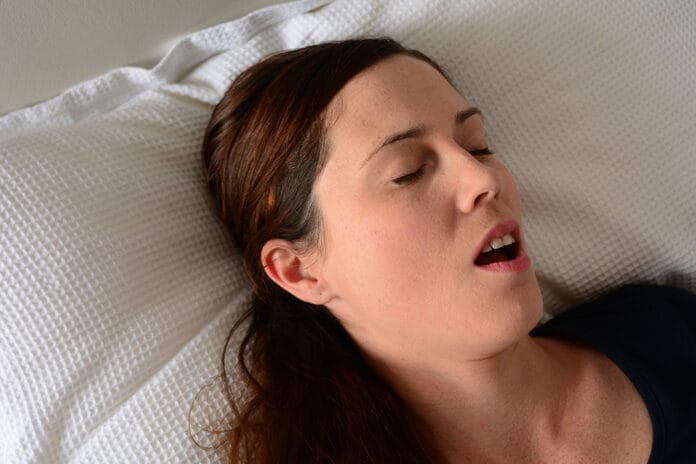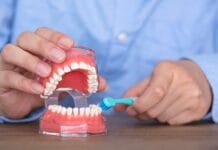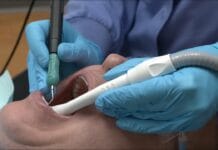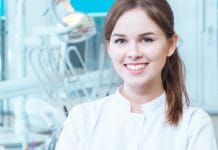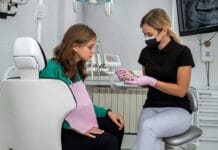Many people do not make the correlation between sleep apnea and dentistry, and it is overlooked or goes unmentioned in the dental setting. However, I like to look outside the box and focus on any medical factors my career can and does encompass. Due to the frequency that dental professionals essentially stare down patients’ throats, I find the path to a diagnosis of sleep apnea can most certainly begin at a routine dental appointment.
Recently, a patient shared about a procedure to control his sleep apnea. This was the first time I had heard of this particular treatment, and I took it upon myself to look further into the procedure.
Obstructive Sleep Apnea
Obstructive sleep apnea (OSA) is a sleep disorder in which affected individuals have complete cessation of breathing or a severe reduction in airflow during sleep due to a repetitive closure of the airway. Globally, 100 million people are thought to have OSA, and an overwhelming 80% remain undiagnosed.1
When a sleeping individual’s breathing is reduced and inadequate oxygen is taken in, these episodes are classified as hypopnea. When breathing completely stops while sleeping, it is called apnea. OSA is classified on the apnea-hypopnea index (AHI) depending on how often the episodes occur within an hour.2
The most common method to treat sleep apnea is through positive airway pressure (PAP) treatment. The most common and considered standard of care of PAP methods are continuous airway pressure (CPAP) and bilateral positive airway pressure (BiPAP). These sleep apnea machines are worn over the airway while sleeping to help increase oxygen levels.3
Another method to treat sleep apnea is oral appliances similar to mouth guards. These appliances are called mandibular advancement devices. These devices are available through a dental provider and help to advance the mandible and open the bite for airflow during sleep.4 Those with OSA who find it hard to comply with a PAP machine may consider this as an alternative treatment.5
Patients diagnosed with obstructive sleep apnea should be given relevant information explaining the various types of treatments available. Research reveals that when patients are afforded the opportunity to decide which treatment they prefer, their adherence to therapy is higher.5
Upper Airway Stimulation
In May 2014, the FDA approved a treatment for OSA called Inspire upper airway stimulation (UAS) therapy. The genioglossal muscle is a determining factor in upper airway obstruction, and UAS therapy stimulates the hypoglossal nerve to activate this muscle. The Stimulation of Sleep Apnea Reduction (STAR) study conducted on hypoglossal nerve stimulation was pivotal in proving that this stimulation could help aid those with OSA.6
The STAR study was conducted on 126 individuals who struggled to initiate or maintain the CPAP therapy. Results indicated that the stimulator was associated with a 68% reduction in the apnea-hypopnea index (AHI), from 29.3 events an hour to nine events an hour at 12 months.6 The study went on to show that participants had improvements in daytime sleepiness and functional outcomes of sleep.6
Qualifications for UAS therapy include:
- At least 18 years of age
- Moderate to severe OSA
- Difficulty accepting or adhering to a CPAP
- Body mass index (BMI) below 33 kg/m2
- No significant comorbidities such as neuromuscular disease, hypoglossal nerve palsy, severe cardiopulmonary disease, or active psychiatric disease
- No pronounced upper airway anatomic abnormalities
- Anterior-posterior predominant retropalatal collapse on drug-induced sleep endoscopy6,7
UAS Therapy
The screening process requires a drug-induced sleep endoscopy. During the procedure, the opening and closing of the airway are examined. If a patient is a good candidate for UAS therapy, small incisions under the chin, below the collar bone, and the side of the chest below the ribs are made to place the pacemaker-like device into the upper chest cavity with a nerve stimulator extending to the hypoglossal nerve.8
The implanted system consists of three fully implanted components, including a small generator, a breathing sensor lead, and a stimulation lead.8
The device will be activated four weeks post-surgery, followed by a post-operative sleep study to ensure that the device correctly provides proper stimulation. A patient controls their device with a wireless remote that turns it on before sleep and off after awakening. Patients will still be required to return for annual checkups with their providers.8
Implant-related complications can include bruising and tingling of the tongue, which are usually temporary and resolve within weeks.8 Transient tongue weakness and soreness may occur as well. With acclimation, device reprogramming, or both, tongue soreness improves over time.6 Serious complications are rare and occur in less than 1% of patients.8
Dental Patients with an Inspire UAS System
The Inspire system implant manual’s physician instructions to the patient include “inform personal physicians, consulting physicians, or dentists that they have an implanted stimulation system.”9 Patients should be instructed by their physician to carry their Inspire Medical Systems ID card at all times.9
The implantable pulse generator (IPG) “is designed to ensure immunity from most common sources of electromagnetic disturbance. In most cases, turning off the electromagnetic disturbance source or moving away from the electromagnetic disturbance source will return the IPG to normal operation.”9 However, the manual states that “extremely strong sources of electromagnetic disturbance could interfere with normal IPG operation, causing the IPG to reset and requiring the IPG to be reconfigured.”9 Examples of strong sources include defibrillation (i.e., AED for cardiac arrest) and radiation therapy for cancer treatment. To reduce the possibility of electromagnetic interference, patients are recommended to use therapy only while asleep.9
Regarding dentistry, the Inspire system implant manual explains that exposure to diagnostic radiographs should not affect the IPG or leads.9 As with any implantable electrical device, if any questions arise regarding dental care treatment modifications or contraindications, dental professionals should reach out to the patient’s physician for guidance. Any physician guidance should be documented in the patient’s chart.
Assisting With Diagnosis
Making it a routine habit to evaluate patients for sleep apnea will help dental professionals provide valuable information to their patients. While dental professionals can not diagnose sleep apnea, they can help initiate the diagnosis with a doctor who can.
A two-minute questionnaire developed by the University of Toronto called the STOP-Bang can help determine if a patient is at risk.1 Dental-related risk factors that dental professionals can physically assess include jaw structure, size of the neck, enlarged tonsils or tongue, gastroesophageal reflux, deviated septum, and obstructive breathing when placed in the supine position in the dental chair.10
Having these conversations with patients is important to help improve their quality of life. Many patients have a personal relationship with their dental professionals and will value and appreciate their professional opinion. While we are well aware of how much we are part of the mouth-body connection, providing this type of screening and evaluation will help validate our worth to our patients.
Before you leave, check out the Today’s RDH self-study CE courses. All courses are peer-reviewed and non-sponsored to focus solely on pure education. Click here now.
Listen to the Today’s RDH Dental Hygiene Podcast Below:
References
-
- The Official STOP-Bang Questionnaire. (2021). Toronto Western Hospital. http://www.stopbang.ca/osa/prevalence.php
- Obstructive Sleep Apnea. (n.d.). Johns Hopkins Medicine. https://www.hopkinsmedicine.org/health/conditions-and-diseases/obstructive-sleep-apnea
- Summer, J., Singh, A. (2023, November 6). BiPAP vs. CPAP Machines: Breaking Down the Differences. Sleep Foundation. https://www.sleepfoundation.org/cpap/cpap-vs-bipap
- EMA. (n.d.). Glidewell Dental. https://glidewelldental.com/solutions/sleep-dentistry/mandibular-advancement-devices/ema
- Almeida, F.R., Bansback, N. Long-Term Effectiveness of Oral Appliance versus CPAP Therapy and the Emerging Importance of Understanding Patient Preferences. Sleep. 2013; 36(9): 1271-1272. https://doi.org/10.5665/sleep.2938
- The Emerging Option of Upper Airway Stimulation Therapy. (2018, February 10). Mayo Clinic. https://www.mayoclinic.org/medical-professionals/pulmonary-medicine/news/the-emerging-option-of-upper-airway-stimulation-therapy/mac-20431242
- The Five Steps to Inspire. (n.d.). Path to Inspire – Inspire Sleep. Inspire Medical Systems. https://www.inspiresleep.com/path-to-inspire/
- Inspire Therapy for Obstructive Sleep Apnea. (n.d.). University Hospitals. https://www.uhhospitals.org/services/Ear-Nose-and-Throat-Services/conditions-and-treatments/inspire-therapy-for-obstructive-sleep-apnea/how-it-works
- Inspire System Implant Manual [200-079-101 Rev A_5]. (2014). Inspire Medical Systems. https://www.accessdata.fda.gov/cdrh_docs/pdf13/P130008d.pdf
- Obstructive Sleep Apnea. (2021, July 29). Mount Sinai. https://www.mountsinai.org/health-library/report/obstructive-sleep-apnea

